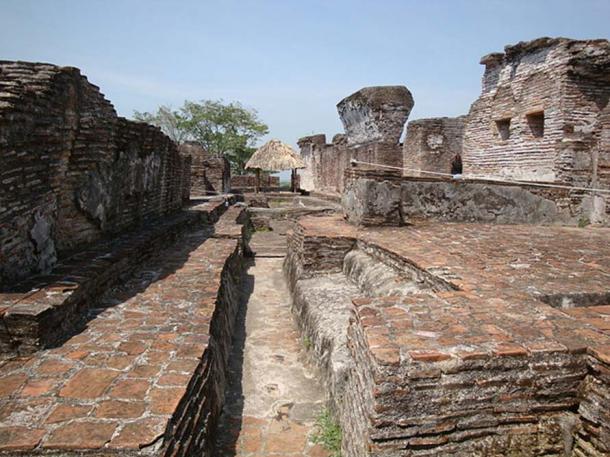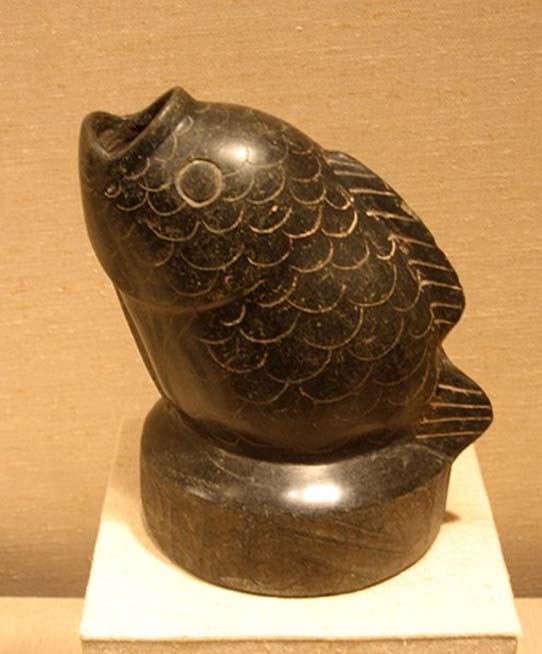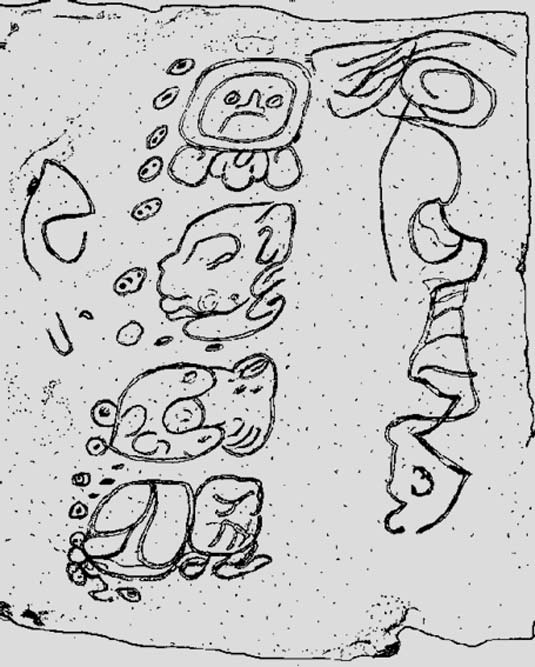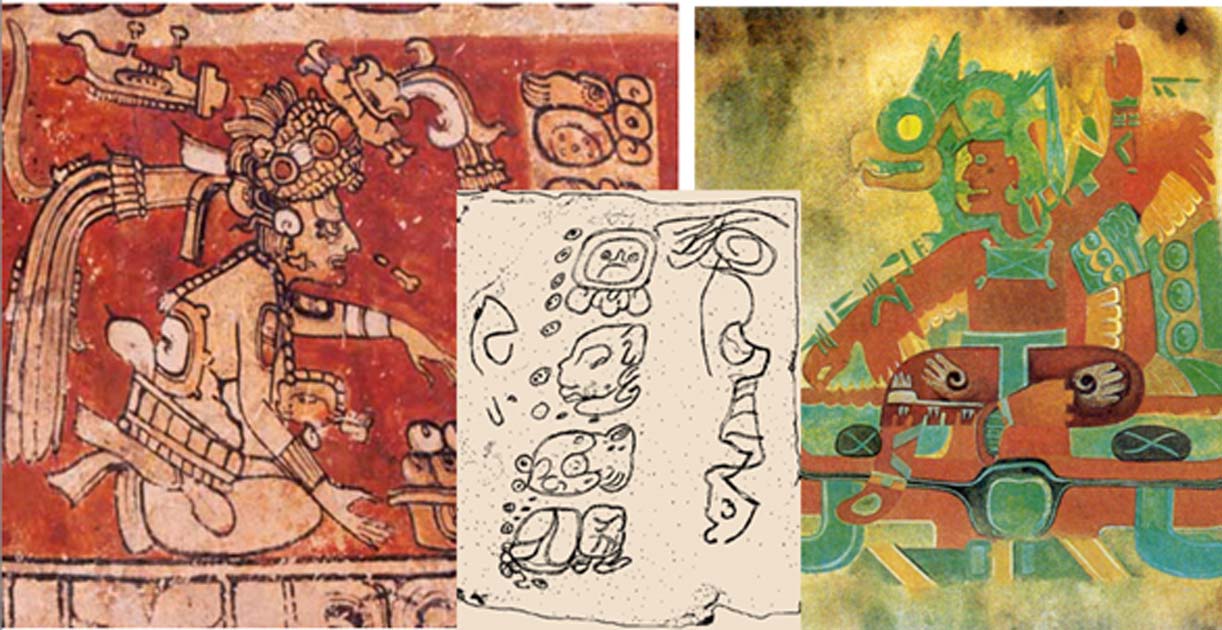Hidden in the Glyphs: Deciphering Bilingual Mayan-Olmec Text
In my book, Olmec Language and Literature, I explain how I deciphered the Olmec language. One of the most important documents used in my research was a Bi-lingual Mayan-Olmec text inscribed on a brick.
The Site of Comalcalco
Support for my decipherment of the Olmec writing comes from a bilingual Mayan-Olmec/Mande inscribed brick from Comalcalco (“in the house of earthenware" in Nahuatl). Comalcalco is a Mayan archaeological site found in Tabasco, Mexico. It was built by the Chontal and is the only ancient Maya city in Mexico entirely built in brick. Archaeologist Neil Steede found over 4000 inscribed bricks at this site.

Comalcalco archaeological site, Tabasco, Mexico. (Dennis Jarvis/CC BY SA 2.0)
The Comalcalco site encompasses around 360 pyramids. Almost all the structures were built of fired bricks (tabiques). Nine of these pyramids were excavated between 1977-1978. This Mayan site has interesting architecture which served an important purpose. For example, "The Great Acropolis" was probably used for civil and religious practices. In addition to the fine temples, walls, and altars, elaborate “stucco” was used to face the constructions, which resemble images on the sub-pyramids of many Mayan sites and have analogy to Olmec iconography.
- Does the Cascajal Block provide evidence of a written language of the Olmecs?
- Birds, Stones, and Jaguars: Piecing Together the Multifaceted Ancient Olmec Religion

Inside the Great Acropolis of Comalcalco, Tabasco, Mexico. (Alfonsobouchot/CC BY SA 4.0)
Intriguing Bricks
Neil Steede became interested in the bricks in 1979 and he obtained permission to photograph them from the Mexican National Institute of Anthropology and History (INAH). Steede published many of the inscribed bricks from the Comalcalco ruins in a bilingual book entitled Preliminary Catalogue of the Comalcalco Bricks. One of the bricks, T1-452 R16, is a particularly fascinating artifact for those interested in Olmec-Mayan connections.

A photo of brick T1-452. (Author Provided)
This brick has a bilingual Mayan-Olmec inscription, with the Mayan inscription on the left and an Olmec/Malinke inscription on the right-hand side. The Olmec writing used on this brick is in the plain style. The plain Olmec style of writing was usually used to inscribe celts and other Olmec artifacts. There are two additional characters on the far right hand side of the brick which are also written in the plain Olmec style of writing.
Dr. Alexander von Wuthenau advised Steede to send me copies of the images of the bricks before his publication of the Comalcalco Catalogue. He did this to determine if I could identify the writing on some of the bricks which Steede thought looked like scripts from the Old World.
I immediately recognized that the T1-452 R16 brick appeared to include both Mayan and Olmec inscriptions. To test this hypothesis, I suggested to Steede that he decipher the Mayan inscription, and I would decipher the Olmec passage which had been partially defaced.

The bilingual Olmec-Mayan inscription. (Author Provided)
Deciphering the Text
Steede agreed to this test. He then divided the inscription into three segments we were both to decipher and we began our work. Below is the division of the T1-452 R16 text:

Division of the T1-452 R16 text. (Author Provided)
I sent a copy of my decipherment of T1-452 R16 to Steede. I included a translation of the Malinke inscription on the right-hand side of the T1-452 R16 brick, and the Olmec/Mande signs found inside the Mayan glyphs. The following is a copy of the decipherment I sent to Steede in 1984:

Translation/Transliteration of the Olmec plain signs.
In English, the Olmec plain signs read:
“Thou exist incomplete.
He is the manifestation of life, a talisman in this proximity.
Give birth to this [funerary] habitation.”

Translation/Transliteration of the Olmec Signs inside Mayan Glyphs.
In contrast, the Olmec signs inside the Mayan glyphs say:
“The person of considerable dignity is void of breath.
[He goes to me the] Jaguar God.
[He] is no longer alive/ or Powerful Righteousness!
[His] Place of rest exist here.”
- The mysterious civilization of the Olmecs
- Possible sacred maize object found in stream at Olmec site

A seated Olmec were-jaguar statue. (rosemania/CC BY 2.0)
Steede wrote me back on March 28, 1984 to say that his interpretation of the Mayan signs was almost identical to my translation of the Mayan and Olmec/Mande signs. He wrote:
"1A shows a face with slashed eyes (blind or non=seeing), nostriless nose (non-breathing) and "clamped shut" mouth (non-speaking). This would indicate death alright, but below the cartouche is added onto by two breath scrolls on each side of an intricate sacrificial blade. These breath (or speak) scrolls indicate that the person in question has expressed that he feels as though he is "dead" spiritually and wishes to make a self-sacrifice.
1B underlines the fact that he is dead, but note the "S" in the ear of the jaguar. This indicates penitence, or repentance. Therefore, though the person is "dead" spiritually he has heard and accepted repentance.
Therefore, 1A and 1B together would read extremely similar to your hieroglyphic translation. but almost exactly as your Manding translation. The person in question is considered to be incomplete until he accepts the priesthood.2 is identical to your Manding translation and similar to your hieroglyphic interpretation. The part to the right is a dorsal fish fin.
I don't have any notes in front of me but I believe it is Stela 1 of Izapa which shows that Quetzalcoatl "fishes" for all types of fish (men). This stela also implicates that the dorsal fish fin is associated with priesthood.
Here we can see the fish fin "hatching" from an "egg?" or from "inner self?" The person in question is being born again as a priest.3. I can't understand, but your rendering would seem to be correct. He is now at rest because he is (complete)."

Ceramic fish-shaped vessel identified as Olmec. Painted black with traces of cinnabar. 1200 - 900 BC. (Madman2001/CC BY SA 3.0)
Was Comalcalco a Mayan College?
The translation of the Mayan side of this bilingual brick from Comalcalco, and other inscribed bricks from the site, indicates that it was probably a Mayan college where scribes learned Mayan writing and possibly pyramid construction.
The bilingual text on T1-452 R16 also indicates that the Mayan scribes had to learn how to write Olmec inscriptions and translate them into the Mayan language. The fact that the Olmec inscriptions were defaced suggests that the scribes first wrote a piece in Olmec and then wrote the same inscription in the Mayan language(s) they studied. A drawing of T1-452 R16 is below. If you look carefully you can see two Olmec signs written vertically.

Drawing of the inscriptions on Comalcalco brick T1-452 R16. (Author provided)
Reading from top to bottom, one sees the signs Ma yo. The interpretation of Ma yo in Olmec is the following: "It's done well--full of life". These signs appear to indicate a grade or comment on the brick, probably made by the instructor. This supports the view that Comalcalco was a college where Mayan initiates entering the priesthood and scribal classes learned how to write Mayan hieroglyphics.
- Olmecs, Ancient American Civilization with African Characteristics
- Archaeological Findings push Mayan Civilizations further back in time
The Origins of Mayan Writing
B. Stross (1973) mentions a Mayan belief in the foreign origin of Mayan writing. This idea is confirmed by Mayan oral tradition, Tozzer (1941), and C.H. Brown (1991), who claimed that writing did not exist among the Proto-Maya. Many experts agree that the Olmec people taught the Maya how to write (Schele & Freidel, 1990; Soustelle, 1984).
Terrence Kaufman has proposed that the Olmec spoke a Mexe-Zoquean speech, however this view fails to match the epigraphic evidence. The Olmec people spoke a Manding (Malinke-Bambara) language and not Zoquean. There is a clear African substratum for the origin of Maya writing (Wiener, 1922). Mayanists also agree that the Proto-Maya term for writing was *c'ihb' or *c'ib'.

Mayan Terms for Writing.
The Mayan /c/ is often pronounced like the hard Spanish /c/ and has a /s/ sound. Brown (1991) argues that *c'ihb may be the ancient Mayan term for writing, but it cannot be Proto-Mayan because writing did not exist among the Maya until 600 BC. This was 1500 years after the breakup of the Proto-Maya (Brown, 1991).
Landa's claims about the origin of Mayan writing support the linguistic evidence (Tozzer, 1941). Landa noted that the Yucatec Maya said they learned writing from a group of foreigners called Tutul Xiu, from Nonoulco (Tozzer, 1941).

A map of the Olmec heartland. The yellow sites are known Olmec villages and towns. The smaller red dots mark locations where artifacts or art have been found unassociated with habitation. (CC BY 3.0)
The Tutul Xiu were probably Manding-speaking Olmecs. The term Tutul Xiu can be translated with Manding: Tutul, "Very good subjects of the Order" and Xiu, "The Shi (/the race)". Thus, "The Shis (who) are very good Subjects of the cult-Order". The term Shi is also probably related to the Manding term Si, which was used as an ethnonym (name given to an ethnic group).
The Mayan term for writing is derived from the Manding term: *se'be. There are various other terms used by the Manding/Mande people for writing.

Manding Terms for Writing.
Brown has suggested that the Mayan term c'ib' diffused from the Cholan and Yucatecan Maya to other Mayan speakers. The term is probably derived from Manding *Se'be which is analogous to *c'ib'. This would explain the identification of the Olmec or Xi/Shi people as Manding speakers. There are also many cognate Mayan and Manding terms (Wiener, 1920-22).
It is clear that the Olmecs introduced writing to the Maya. As a result, the Mayan term for writing is of Olmec/Mande origin. This view is confirmed by Steede and Winters’ decipherment of the Comalcalco brick T1-452 R16.

Famous stone head of the Olmec civilization. Source: BigStockPhoto
Top Image: An Olmec cave painting from the Oxtotitlan Cave, Chilapa de Alvarez, Guerrero, Mexico. (latinamericanstudies.org) A depiction of the Maya god D, Itzamná. (Public Domain) Drawing of the inscriptions on Comalcalco brick T1-452 R16. (C. Winters)
References
Brown, C.H. (1991). Hieroglyphic literacy in ancient Mayaland: Inferences from linguistics data. Current Anthropology, 32(4), 489-495.
Coe, M. (1989). The Olmec Heartland: evolution of ideology. In R.J. Sharer and D. C. Grove (Eds.), Regional Perspectives on the Olmecs (pp.68-82). New York: Cambridge University Press.
Delafosse,M. "Vai leur langue et leur systeme d'ecriture", L'Anthrpologie 10, 1899.
Gutherie, J. (ed.).(1995). The Olmec World: Ritual and rulership , Princeton University: The Art Museum.
Hau, K. (1973). Pre-Islamic writing in West Africa. Bulletin de l'Institut Fondamental Afrique Noire (IFAN), t 35, Ser. B number 1, 1-45.
Hau, K. (1978). African writing in the New World. Bull. de l'IFAN, t 40, Ser. B , number 1, 28-48.
Morley, S.G., Brainered, G.W. & Sharer, R.J. (1983). The
Ancient Maya. Stanford: Standford University Press.
Landa, D. de. (1978). Yucatan before and after the Conquest.
(Trans. by) William Gates. New York: Dover Publications.
Norman, G. (1976). Izapa Sculpture.
Navarrete, C. (1976). The Olmec rock carving at Pijijipan Chiapas, Mexico and other Olmec Pieces, from Chiapas and Guatemala. New World Archaeological Foundation, No. 35. Provo, Utah : Brigham Young University Press.
Pouligny, D. (1988). Les Olmeques. Archeologie, 12, p.194.
Rafineque, C. (1832). "Second letter to Mr. Champollion on the Graphic systems of America and the glyphs of Ololum [Mayan] of Palenque in central America-elements of the glyphs", Atlantic Journal 1, (2) :44-45.
Sahagun, R. de. (1946). Historia General de las Casas de la Nueva Espana. Mexico City: Editoria Nueva Espana.
Schele, L. & Freidel, D. (1990). A Forest of Kings. New York: William Morrow and Company, Inc.
Smith, V.G. (1984). Izapa Relief Carving. Washington, D.C.:
Dumbarton Oaks Research Library and Collection.
Stross, B. (1973). Maya Hieroglyphic writing and Mixe-Zoquean. Anthropological Linguistics, 24 (1), 73-134.
Tate, C. E. (1995). Art in Olmec Culture. In J Gutherie (ed.), The Olmec World: Ritual and rulership (pp.45-67)
The Art Museum, Princeton University.
Tozzer, A.M. (ed).(1941). Relacion de las Casa de Yucatan. Peabody Museum of American Archaeology and Ethnology ,1941.
Wiercinski, A. (1972). Inter-and-Intrapopulational racial differentiation of Tlatilco, Cerro de Las Mesas, Teothuacan, Monte Alban and Yucatan Maya. XXX1X Congreso International de Americanistas, Lima 1970, Vol. 1, pp.231-252.
Wiercinski, A. & Jairazbhoy, R.A. (1975). The New Diffusionist, 5 (18), 5.
Winters, C.A. (1977). The influence of the Mnade scripts on American ancient writing systems. Bulletin de l'IFAN, t.39, Ser.B ,Number 2, 405-431.
Winters, C.A.(1979). Manding writing in the New World--Part 1, Journal of African Civilization, 1 (1), 81-97.
Winters, C.A. (1980). Appendix B: The Jade Celts of La Venta.
In A. von Wuthenau, Unexpected faces in Ancient America (pp. 235-237). 2nd Edition. Mexico.
Winters, C.A. (December 1981/ January 1982). Mexico's Black heritage, The Black Collegian,76-82.
Winters, C.A. (1983). "The ancient Manding script". I. Sertima (Ed.), Blacks in Science: ancient and modern, (ed.) by I. Sertima, (pp. 208-214), London: Transaction Books.
Winters, C.A. (1984a). Blacks in ancient America. Colorlines, 3(2), 27-28.
Winters, C.A. (1984b). Africans found first American Civilization, African Monitor, 1, 16-18.
Winters, C.A. (1986)."The Migration routes of the Proto-Mande", The Mankind Quarterly 27 (1), 77-96.
Winters, C.A. (1997, April). The decipherment of Olmec Writing. Paper presented at the 74th meeting of the Central States Anthropological Society, Milwaukee, Wis.
Winters, C. (2015). Olmec Language and Literature. https://www.amazon.com/Olmec-Language-Literature-Clyde-Winters/dp/1507587244
Wuthenau, A. von. (1980). Unexpected Faces in Ancient America. 2nd Edition. Mexico.




















Comments
Cut out the arbitrarily-inserted fabrications of any African influence and it might just be plausible.